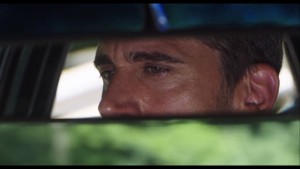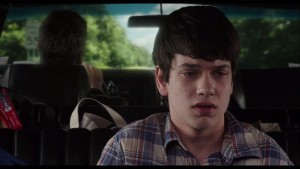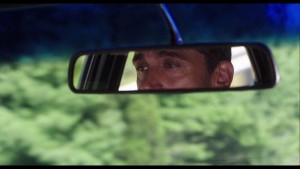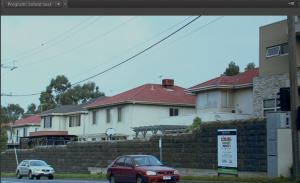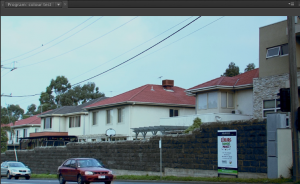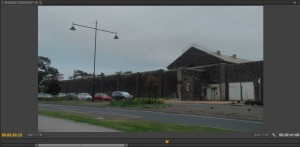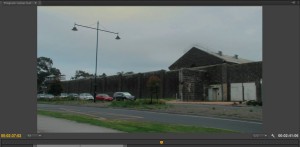This week I feel as though there is a lot to reflect on, so I’m going to break it down into subheadings. Terms like ‘unique’, ‘complicated’ and ‘simple’ you’ll find will probably be in quotation marks as I feel like these terms will form part of my research into camera coverage and their definitions to me will most likely change over time.
FOUND SCENE:
The task of finding a scene and analysing the camera coverage sounded interesting and exciting, until I had to choose an actual scene. The issue I found wasn’t discussing the camera coverage and possible reasons the filmmakers chose to use certain shots, but rather finding a scene that was ‘unique’ in the way it had been covered. I didn’t think it would be difficult at all to find a scene from some of my favourite films, as one of the main reasons why I loved these films is due to their scene constructions, right? As it turns out I was wrong.
As I began to pull apart some of my favourite films, isolate and analyse particular scenes that had impacted me, I began to realise that there were reasons other than the camera coverage that helped me connect with the film. When I isolated particular scenes and watched them repeatedly to find some kind of meaning behind the camera coverage, I found that even listening to the dialogue out of context at times made the dialogue sound contrived. This was quite frustrating as I began to feel as though my judgement of these films as being amazing was not as well considered as I originally thought. Perhaps these films stood out to me for the way in which the film as a whole worked together (with the script, cinematography, and performances working together) and the scenes themselves were just building blocks towards the climax with nothing ‘unique’ about the camera coverage.
This prompted many questions as I became quite frustrated in trying to find a scene based on camera coverage that I could analyse and describe the possible meaning and reasons behind the chosen set-ups. How is it that these films that had stood out of the pack and I had encouraged my friends to watch have ‘simple’ scene constructions and camera coverage? Did the director purposefully use ‘simple’ camera set-ups in order to allow the actors performances to shine through? Did the tone and slow-burning rhythm of the films mean that using more complicated camera coverage would distract the viewer from the action? Or were the reasons purely to do with the place and time the films were made (eg; Hollywood)?
What I found to be an interesting scene to analyse came from an unlikely film in The Way Way Back. While I did really enjoy watching this film, the cinematography and camera coverage didn’t originally stand out to me. It was only until I decided to pick apart the scenes that I began to gain more appreciation for it’s camera coverage.
Questions like these will continue to form my research throughout the semester and challenge the way I think about camera coverage and scene construction.
WEDNESDAY EXERCISE:
I found Wednesday’s exercise to be much more challenging than last week’s exercise, not just because of the constraints of the task (editing in camera, 3-5 shots) but because my group again had (I never thought I would say this) a script to work off. A couple of people who had been in my group last week agreed that having a script seemed to be more of a creative limitation than just having a scene description. We found ourselves spending more time scrutinizing the script and feeling forced to follow the script to a tee. Every creative shot we came up with was then changed to accommodate the script’s specific actions. We also had to decide where our minimum 3 shots and maximum 5 shots would be placed according to the script which also restricted our creativeness as we resigned ourselves to showing, for example, Antonio walking towards Susan and Linda as the script told us to, rather than changing the action to suit our creative vision.
Having come from the Screenwriting course, I have always been able to visualize how I would expect my scripts to be adapted to the screen. I had been trained to write in a way that was instructive to the director, yet leaving room for a director’s creative visual choices. So finding this task as being restrictive because of the script was quite bizarre for me, however I found myself saying “I wish we didn’t have a script.”
Seeing the way in which the other two groups were able to create visually interesting, beautiful, and even hilarious scenes by their camera coverage choices compared to ours made it clear that the material you have to work from as well as the individual’s vision can create such starkly different scenes. I was really blown away by some of the shots that they had created and even felt a ping of jealousy that they were able to interpret their given scene in a purely creative way with less restrictions.
FRIDAY EXERCISE:
So I got another script to work with for Friday’s exercise. Being a bit disappointed that I couldn’t experiment with a different form of instructive text, I tried to really think of creative ways to show the action without feeling restricted by the specifics in the script. While a couple of people went and scouted for a location, the rest of us discussed some really interesting ideas, however when we arrived on the location it became apparent that we couldn’t film all of the shots exactly how we wanted. One of the issues we came across in the script was that the character in one action goes from having her head out of a window to looking into a mirror on a wall. In our discussion we thought it would be interesting to use the camera as a mirror and have the actor look directly into it.
We still came up with a few dynamically interesting shots and were really excited to shoot them especially because we had such a cool backdrop of the city (our location was a balcony). Because the location that was chosen by our two location scouts was exterior and there was no mirror to use, we improvised by using the camera on a mobile phone as the mirror. While at the time it seemed like a great solution, I feel as though if we had found an interior location with a mirror, we would’ve had more opportunity to play around with the reflections and create something quite unique. Other concerns about the location were the cramped nature of the balcony and the noise from nearby construction.
After discussing the shots in the location and cutting the script into the maximum 6 shots we were allowed, we began shooting. We shot out of order so that we wouldn’t have to continually move the camera’s position. After each shot, we rotated roles so that most people could have a go at filming a shot. While we all agreed this was a great idea, the cramped quarters of our location made it difficult to oversee what other people’s shots looked like. While at the time we thought the shots looked great, it wasn’t until we actually got to see the shots properly in post that it became clear that they weren’t executed as well as we thought (eg; focus, exposure, camera balance, height of tripod – not showing the backdrop that well).
Having to stick to the industrial model and log our takes also became quite tedious. This process might be helpful for a bigger shoot with more shots (eg; a short film) but for one scene it seemed pointless. When I began reviewing and assembling the shots in post, I followed the log sheet, however I found that with a bit of tweaking to overcome the continuity issues recorded in the log sheet, I could use the lower rated shots and actually sometimes preferred using them. While we had more ‘freedom’ with this exercise, it became clear that perhaps having more constraints meant that we had to think more outside of the box and more creatively in previous exercises rather than this one.
While it was a collaborative effort and everybody had a small contribution, I feel as though maybe we didn’t all get a say in how the scene was shot and that there were great creative opportunities that were missed. Not letting everyone’s voices be heard meant that their great ideas were also missed out on, which is a real shame. While we are each supposed to be experimenting and creating an understanding about our own methodology, I don’t feel like everyone is being able to speak up and grow individually as a filmmaker. I think this really does depend on the dynamics of the group and personalities, which can make people feel like taking a back seat rather than contributing their thoughts. While we don’t have enough cameras or time to allow every student to film their own scene, I think there may be other ways to try and overcome this issue. I think a way to overcome this might be to in the next filming exercise, rather than discuss the shots as a group, have each person mark up the scene with how they would film it. Then go around the table and discuss what each person came up with, and have a constraint be that each person must have at least one of their shots filmed and filmed by them. Maybe this is a good idea, maybe it would make the scene look fractured, I’m not sure, but at least everyone would be able to present their ideas and learn from them.
